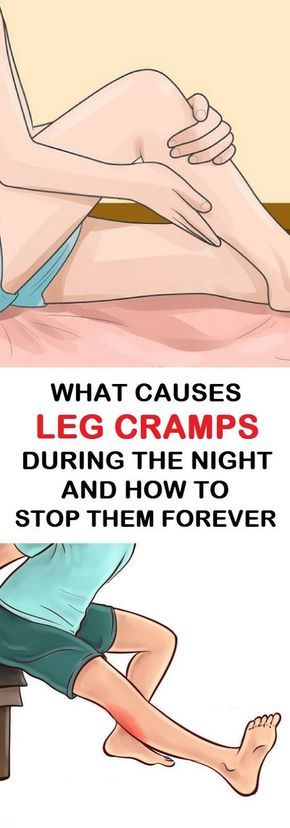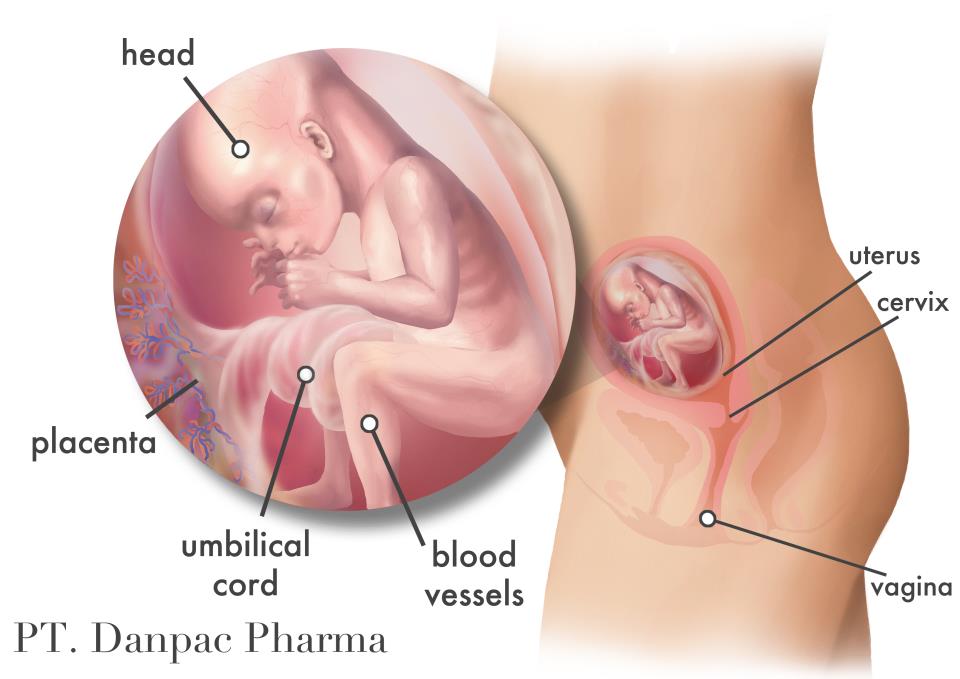Postpartum c section exercises
Exercise after c-section: When and how to start
Generally, you can start easing back into exercise six to eight weeks after having a c-section. It’s important to note that you may not have the same c-section recovery experiences and timelines as other people you know who have had caesarean deliveries, so it’s key to listen to your own body and your healthcare provider's recommendations.
There are some very light exercises and movements you can do prior to your six-week postpartum checkup, including light pelvic floor exercises (such as Kegels), gently tightening your abdominal muscles in a sitting or lying position to activate them, and – the holy grail of post c-section exercises – walking.
In most cases, there are no restrictions on walking at a casual pace, but it's best to avoid any power walking until you get that all clear from your ob-gyn or midwife. Many healthcare providers recommend that you start with short, slow-placed walks once you’re no longer experiencing any post-birthing bright red vaginal bleeding.
It may feel challenging to wait to resume an exercise routine if you loved movement before your baby’s birth, but it will be worth it. You just had a major abdominal surgery, which involved cutting through many layers of abdominal tissue, and taking it slow is essential to avoid experiencing any potential complications or setbacks.
At your six-week checkup, your healthcare provider will screen for a variety of issues – they'll check to make sure your incision is healing property and will talk with you about contraception plans and any possible mental health concerns. If your recovery is going well and there aren't any major complications, they'll likely tell you it's okay to start exercising. (This is also when you'll usually receive the go ahead to resume having sex as well.)
Your healthcare provider might also refer you to a pelvic floor therapist for more specific instructions on exercises for postpartum recovery, especially if you're experiencing additional issues such as pelvic pain or postpartum incontinence.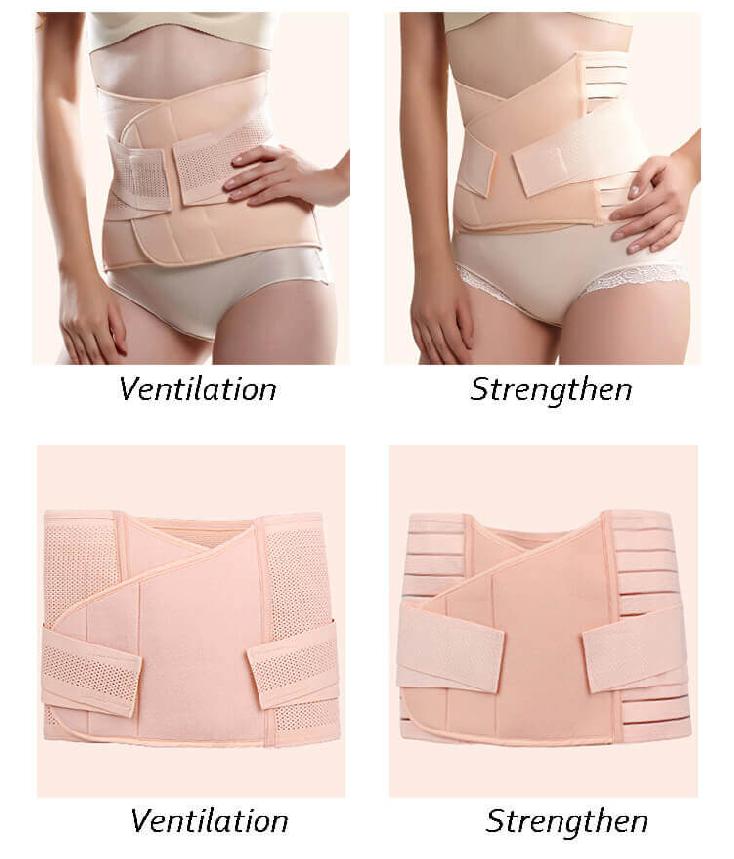
You don't have to wait for this appointment to contact your provider if you're having any concerns about what activities are okay after a c-section – or if you're experiencing any other postpartum challenges for that matter. It's always okay to reach out if you have questions.
The benefits of postpartum exercise, when you feel ready to resume it, are extensive. Exercise after a c-section can minimize the effects of diastasis recti, a condition where the connective tissue that joins the two sides of the rectus abdominus muscles thins and widens to allow room for a growing baby during pregnancy. In addition, exercise can help with weight loss, cardiovascular fitness, muscle tone, energy levels (in spite of those sleepless newborn nights), stress relief, and mental health disorders, including postpartum depression.
Abdominal exercise after c-section
As you set out to recover physically from your c-section, which for many includes abdominal recovery, keep in mind that your c-section “pooch” – or the area around your incision that might still “look pregnant” months after you aren’t anymore – doesn't go away immediately.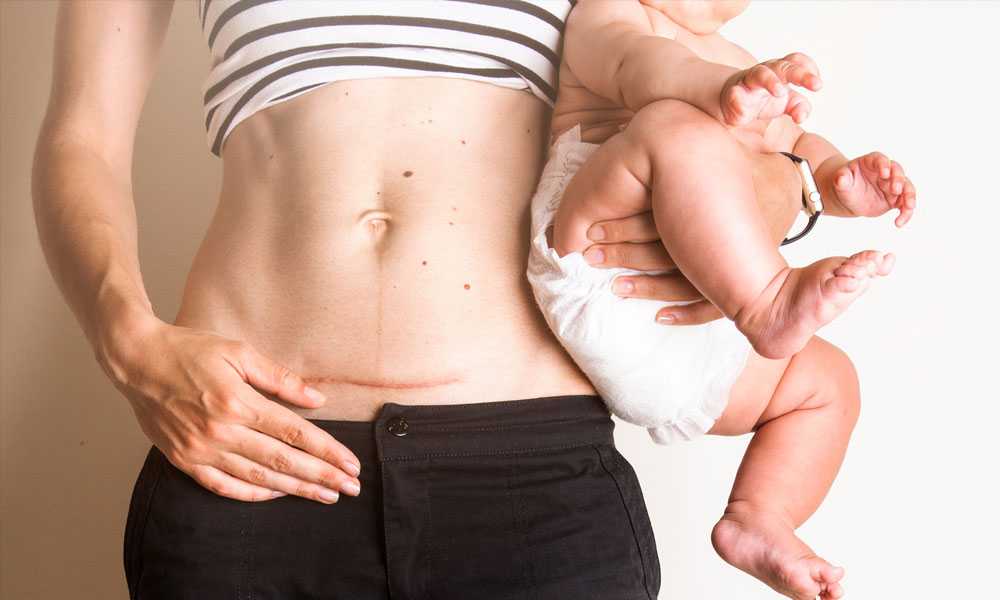
Even if you're focused on flattening your tummy, there’s no such thing as spot reduction, or targeting just that specific area. Instead, you can try to meet your goals through a combination of aerobic exercise and toning. It’s also worth considering that you might not “return” or “bounce back” to the same body that you had before your baby, and that's okay too.
Walking, jogging, swimming, and biking are all great choices for strengthening your ab muscles after a c-section. It's best to avoid sit-ups, crunches, and planks for several weeks.
The "hut" exercise is one immediate postpartum ab exercise that new moms can try: Sit comfortably in a chair or on the floor, take a deep belly breath, and say “hut” quickly five times.
Another great post c-section exercise is an isometric abdominal contraction. To do this, think of drawing your belly button towards your spine and hold for a count of five. Repeat 5-10 times. You can increase the duration of the hold as you become stronger.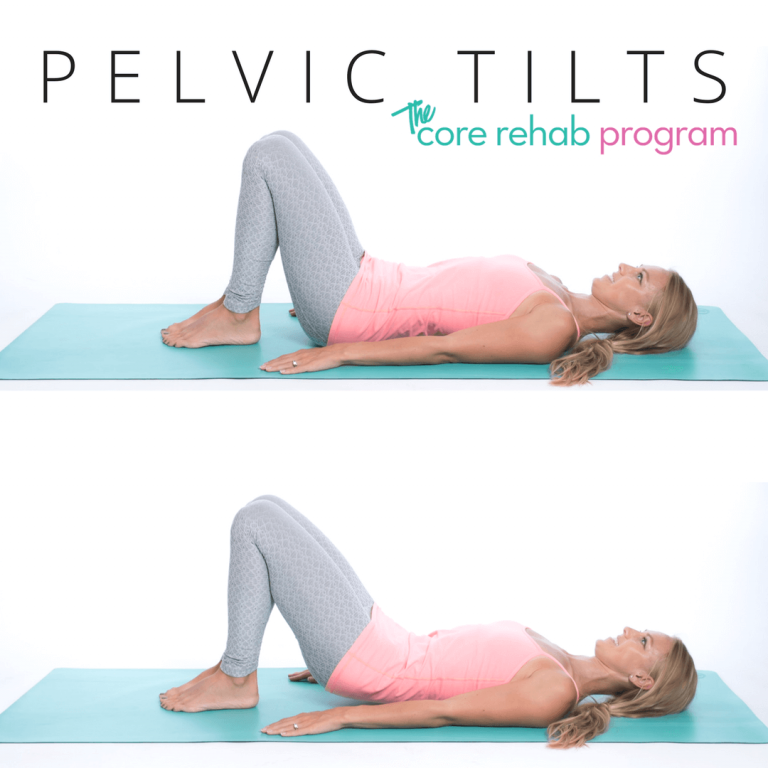
These exercises, along with daily Kegels, will help strengthen those muscles around your core that may have been weakened throughout pregnancy. After you’ve been cleared for more exercise, you can increase the intensity of your postpartum abdominal toning with Pilates, weight lifting, and many other great exercise options.
When can I start low-impact exercise after a c-section?
Following your c-section, it's generally okay to engage in light, low-impact movement, such as walking. (Avoid pounding, jumping, running, or any other intense forms of exercise until you've been cleared by your healthcare provider.) Listen to your body as to how much you can handle, as you may find you don’t have as much stamina as usual, especially right away.
While light walks and other low-impact exercises may not feel like very much, this movement is helping you recover and is laying the foundation for getting back to higher-impact exercise down the road. Plus, a walk outside in the sunshine can be an instant mood-booster.
Your provider might instruct you to avoid swimming, even low-impact swimming, until your incision is fully healed. If you're unsure, call them to ask specifically or wait until your six-week postpartum appointment.
When can I start high-impact exercise after a c-section?
In most cases, you're fine to start high-impact exercise after your healthcare provider has cleared you to do so, usually at your six-week checkup if you haven't had any complications, such as urinary incontinence or other pelvic floor issues. If you're experiencing pelvic floor dysfunction or other musculoskeletal issues, it’s best to get a referral to a pelvic floor physical therapist who specializes in women’s health before getting back to high-impact activity.
Just because your one-hour intense kickboxing session is now fair game, that doesn’t mean you're ready to uppercut your way right back in there. Getting back to your exercise routine postpartum may be a slow and gradual process, and for many moms, it often involves a lot of time and patience, even past that six-week mark.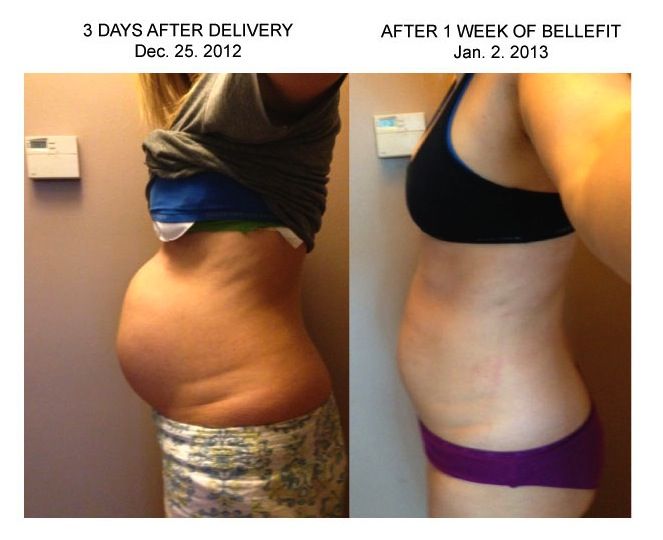
If you're exercising after being cleared to do so, and experience any redness, warmth, swelling, or drainage at your c-section incision sight – or if the incision breaks open – call your healthcare provider right away. In addition, any abnormal vaginal bleeding after exercising is another condition that should warrant a prompt call to your OB or midwife.
Read more:
Postpartum fitness: Simple exercises for the first month
Postpartum belly: How long you might look pregnant
Postpartum exercises: Tightening those abdominals
advertisement | page continues below
7 Postpartum Exercises for C-Section Recovery
For new mothers who’ve recently had a C-section delivery, congratulations on your new baby! Exercise will look a little different for you for the next several weeks. Having a C-section requires a bit more recovery time in order to heal properly and avoid complications. Regaining strength gradually will help you return to doing the activities you love with ease.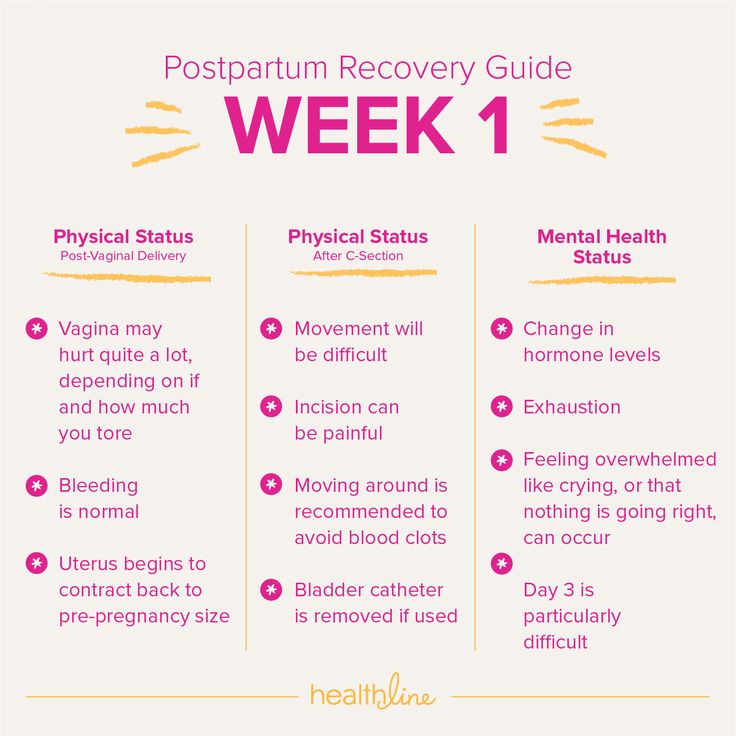
Fortunately, we’ve come up with a few exercises to help you strengthen the core without disrupting the healing process!
Learn more!
- What is a C-Section?
- When Can I Exercise?
- 7 Core Strengthening Exercises
- Additional Recovery Tips
A C-Section, or Cesarean Section, is the surgical delivery of a baby through incisions in the abdomen and uterus. C-Sections are only recommended in emergency medical situations, including high-risk pregnancies and when the baby is in breach position and can't be flipped around before labor begins. In 2018, 21% of all births were delivered by C-section, according to data collected from 169 countries. In the US, more than 30% of all births are C-section deliveries.1
Whether you have a scheduled C-section or not, you should know what to expect before going into surgery!
Here’s What HappensDuring a C-Section, the doctor will first make a small incision in your lower abdomen, just above your pubic hair line.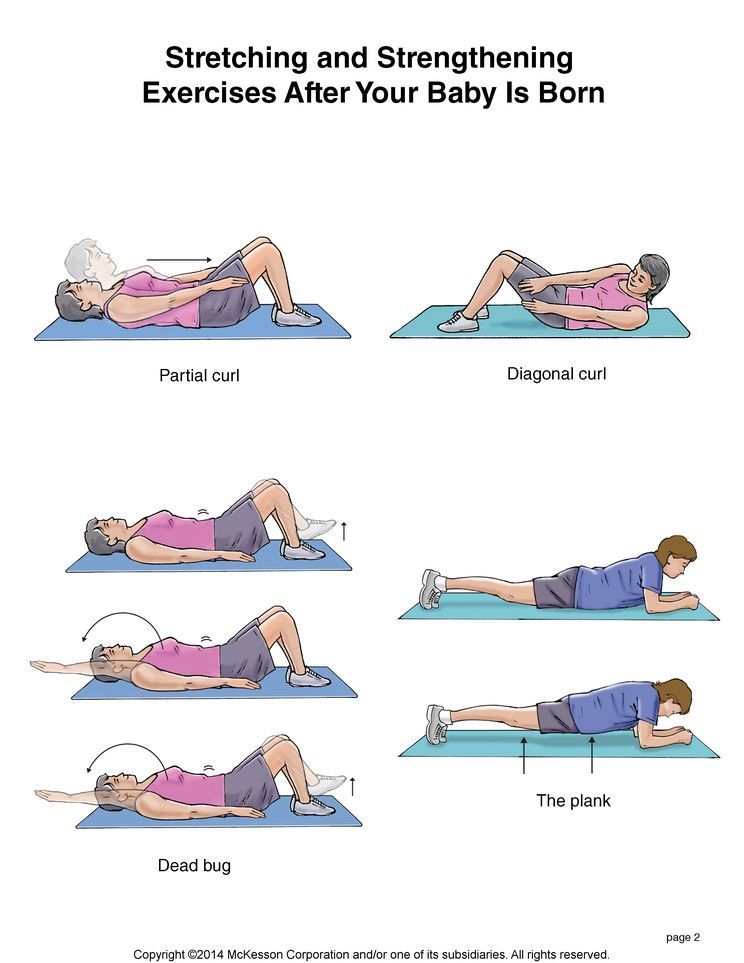 Then another incision in the lower part of your uterus. For both incisions, two options are possible: low-transverse or vertical cut. A low-transverse cut is used in majority of C-Sections because the muscle at the bottom of the uterus is thinner. This incision results in less bleeding and is less likely to tear during future vaginal births after a cesarean (VBACs). A vertical cut is down the middle of your uterus. This incision is only required if the baby is nestled low in your uterus or in another unusual position.
Then another incision in the lower part of your uterus. For both incisions, two options are possible: low-transverse or vertical cut. A low-transverse cut is used in majority of C-Sections because the muscle at the bottom of the uterus is thinner. This incision results in less bleeding and is less likely to tear during future vaginal births after a cesarean (VBACs). A vertical cut is down the middle of your uterus. This incision is only required if the baby is nestled low in your uterus or in another unusual position.
Before an incision is made, an IV and anesthesia (epidural or spinal block) are administered to the lower half of your body. Next, you'll be prepped by having your abdomen washed with an antiseptic solution. Then, a catheter will be inserted into your bladder and sterile drapes placed over your belly. Once the incisions have been made, the amniotic fluid will be suctioned out and the baby will be gently removed. Because the excess mucus in the respiratory tract wasn't squeezed out while the baby makes their way through the birth canal, some extra suctioning will be necessary to clear the lungs.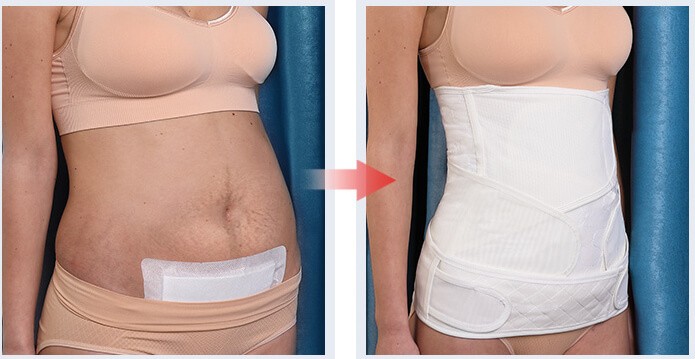
Following surgery, you can expect your scar to be sore for at least a few weeks. Avoid holding and carrying heavy objects — except the baby. When nursing, place the baby on a pillow over your incision to protect the tender area.
When Can I Exercise?You can resume exercise once your doctor gives you permission - typically after the 6 or 8-week postpartum appointment. Even after you’ve been given permission, it’s important to ease into abdominal exercise. Pregnancy puts a lot of strain and pressure on the pelvic floor muscles that support the bladder, bowels, and uterus. During surgery, the bladder is moved to safely deliver the baby. This creates a lot of trauma for those organs and muscles, so it’s important to focus on strengthening them slowly.
Focus on strength training exercises that engage the core, but doesn’t cause it to bulge out. Avoid doing crunches, sit-ups, full push-ups and full planks at first. These exercises put too much pressure on your abdominal muscles and can disrupt healing.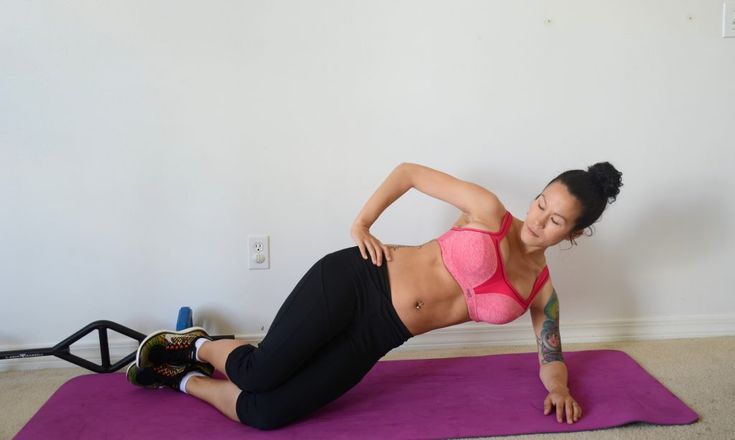 In addition, avoid lifting heavy weights. At the minimum, spend 3-4 months working your way back up to heavy weights.
In addition, avoid lifting heavy weights. At the minimum, spend 3-4 months working your way back up to heavy weights.
Another great way to slowly get back into shape is to add cardio to your post-pregnancy fitness regimen! Make sure to start with low-impact cardio for the first 4-6 months after a C-section delivery. These exercises include walking, swimming, cycling, and elliptical training. As your stamina and strength build up, slowly increase the intensity of your workouts.
7 Core Strengthening ExercisesWe’ve come up with 7 abdominal exercises to help strengthen your core after a C-section delivery. Ideal for body toning, these exercises can be done every day. In addition, it is also good to implement breathing exercises into your routine before or after your workout. Positional breathing exercises can help you regain proper movement of your diaphragm.
Breathing ExercisesStart on your back and relax your body on the floor.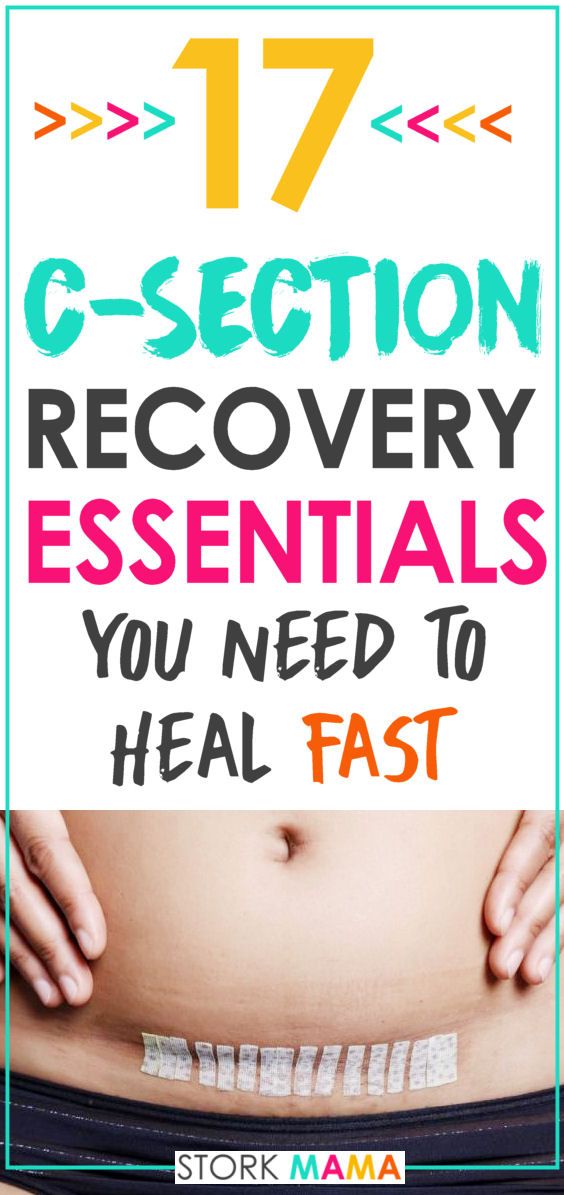 Take a deep breath in through the nose. Hold the breath for 3-5 seconds, and then slowly release as you draw your belly towards the floor and contract your abdominal muscles. Perform this exercise for 1-2 minutes daily to help strengthen your deep core muscles.
Take a deep breath in through the nose. Hold the breath for 3-5 seconds, and then slowly release as you draw your belly towards the floor and contract your abdominal muscles. Perform this exercise for 1-2 minutes daily to help strengthen your deep core muscles.
Glute Bridge
|
Wall Pushups
|
Seated Forward Bend
|
Wall Sits
|
Kneeling Squats
|
Modified Side Planks
|
Chair Tricep Dip
|
- Apply Heat to Your Abdomen: Heat therapy can ease both pain and soreness after a C-section delivery.
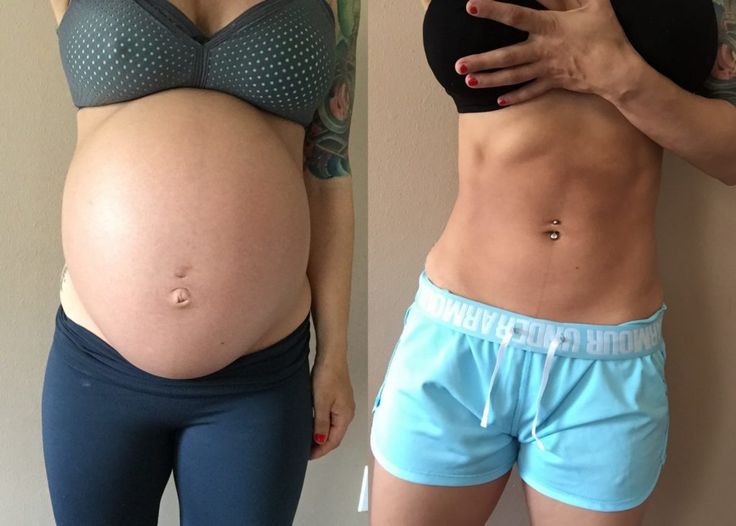 Apply a heating pad to your abdomen in 15-minute intervals. The warm compression is designed to increase blood circulation to the area where it is applied, promoting faster healing
Apply a heating pad to your abdomen in 15-minute intervals. The warm compression is designed to increase blood circulation to the area where it is applied, promoting faster healing
Buy on Amazon!
- Get Plenty of Sleep: In the first few months after their birth, your child is likely to wake several times during the night. Try to rest when your baby sleeps. For additional comfort, use a body pillow to support the lower back and abdomen. The pillow contours to the body's shape to relieve pressure areas for a more restful sleep
Buy on Amazon!
- Massage with Essential Oils: Essential oils have many unique properties. Specifically, lavender helps to reduce the appearance of scars. Research has proven that lavender promotes wound healing by increasing collagen and regenerating tissue. Without causing skin irritation and/or allergic reactions, the essential oil has antibiotic, antioxidant, and antiseptic properties to speed up wound closure3
- Compression Garments: Protect your C-section scar as it heals with a compression garment! Abdominal binders are designed to support the stomach muscles and lower back, helping increase blood flow as you heal from surgery.
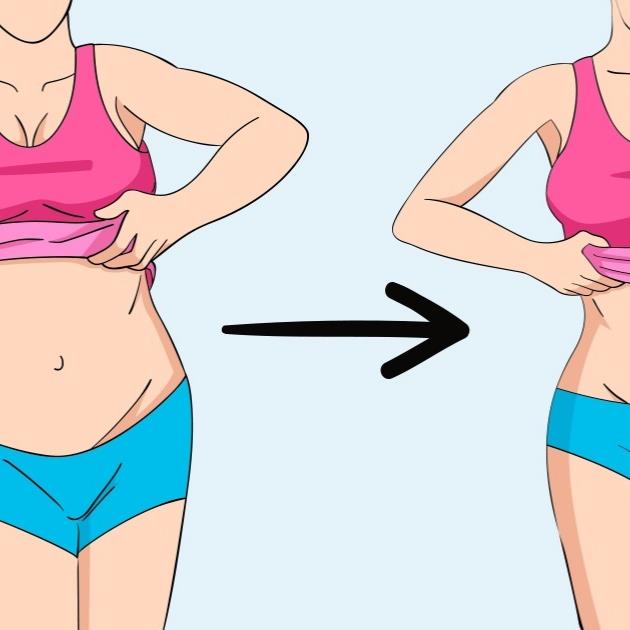 Breathable, lightweight and discreet, the garment provides gentle compression which restricts the expansion of the chest and abdomen
Breathable, lightweight and discreet, the garment provides gentle compression which restricts the expansion of the chest and abdomen
Buy on Amazon!
The biggest change, other than having a new baby, is changing your physical activity until you’ve healed. It could take up to eight weeks for you to get back into your normal routine. Rest when you’re tired, drink plenty of water, don’t lift heavy weights, and call your doctor before you start exercising again. Taking care of yourself after having a C-section is just as important as taking care of your newborn!
Looking for more postpartum exercise tips? Check out these articles!
- Postpartum Exercise: Is Your Body Ready and How to Start
- The Most Important Muscle to Exercise Postpartum: Your Pelvic Floor
References
- Donaldson-Evans, Catherine. (2019). C-Section: What Happens During a Cesarean Delivery. What to Expect. Retrieved from https://bit.
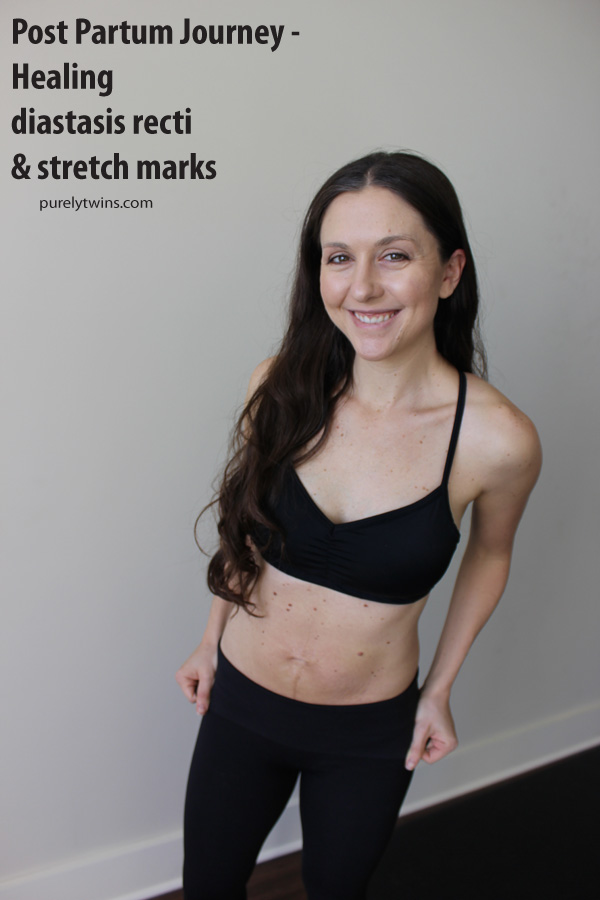 ly/3mp99kc
ly/3mp99kc - Freutel, Natasha. (2018). 5 Exercises to Help with Your C-Section Recovery. Healthline: Parenthood. Retrieved from https://bit.ly/2HyTmQM
- Tolbert, Kendra. (2018). 8 Natural C-Section Recovery Tips to Help You Feel Better Fast. Motherly. Retrieved from https://bit.ly/31EeDzN
Medical Disclaimer: The information provided on this site, including text, graphics, images and other material, are for informational purposes only and are not intended to substitute for professional medical advice, diagnosis or treatment. Always seek the advice of your physician or other healthcare professional with any questions or concerns you may have regarding your condition.
Recent Posts
Categories
Popular Posts
Subscribe toPerformance Health
Want to receive the latest education, articles, and promotions from Performance Health? Sign up now!
90,000 when can you start, so as not to harm your health?January 10, 2020
July 3, 2020
3 minutes
1457
ProWellness
Contents
- What happens during a caesarean section?
- Getting started
- Features of the first training
- What is forbidden while the stitches heal?
Disclaimer
Please note that all information posted on the site Prowellness is provided for informational purposes only and is not a personal program, a direct recommendation for action, or medical advice.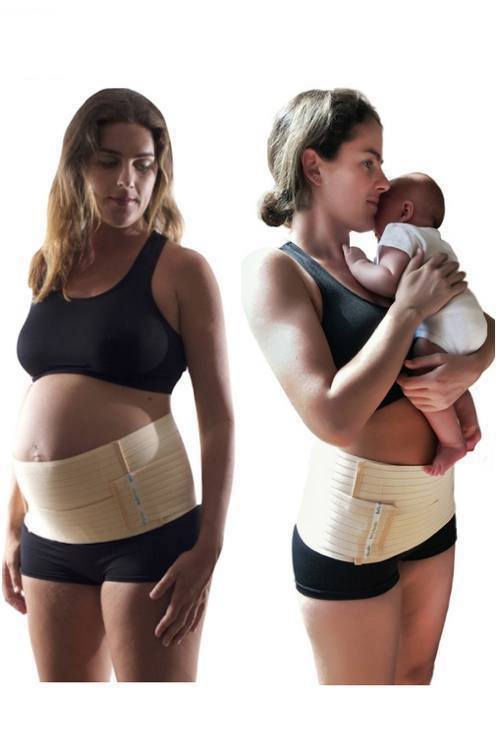 Do not use these materials for diagnosis, treatment, or any medical procedure. Consult your physician before using any technique or using any product. This site is not a specialized medical portal and does not replace the professional advice of a specialist. The Site Owner is not liable to any party who has suffered indirect or direct damage as a result of misuse of materials posted on this resource.
Do not use these materials for diagnosis, treatment, or any medical procedure. Consult your physician before using any technique or using any product. This site is not a specialized medical portal and does not replace the professional advice of a specialist. The Site Owner is not liable to any party who has suffered indirect or direct damage as a result of misuse of materials posted on this resource.
Sports after caesarean section: when can I start in order not to harm my health?
An active lifestyle is good, but there are some restrictions on physical activity after certain surgeries and health problems. Some young women ask if they can exercise after a caesarean section and when they are allowed to start exercising.
What happens during a caesarean section?
This is a surgical intervention that is performed to extract the child. The procedure is always performed under general anesthesia and in 4 stages:
- Incision of the abdominal wall (except for the abdominal muscles, which are simply pulled apart) and uterus.

- Removal of a child.
- Cleaning the uterus from the placenta.
- Suturing.
This is a serious abdominal operation. In the early days, any physical activity is prohibited. Starting from day 10, you can start light exercise after consulting your doctor.
Beginning of classes
Starting from the tenth day, with the approval of the doctor, the first loads in the form of walks should be included in the regimen. You should do squats, bends, light exercises. The first days after the operation, the load will not be quite familiar: the child needs to be carried, rocked, fed. This will give the necessary activity, sufficient for the first days after cesarean.
If there are no complications, light gymnastics is acceptable, but without stress on the press. When a young mother walks with her child, she keeps her active by moving in the fresh air.
Attention! Active training after caesarean can be started at 6-8 weeks if there are no complications.
Features of the first training
Approximately 2 months after the joyful event, you can start training.
An important rule: the load must be increased slowly, with a gradual increase. Do not perform heavy, intense exercises. It is permissible to start with the following complexes:
- Pilates is a selection of leisurely exercises for all the muscles of the body without impact loads, which are safe for the abs and back.
- Water aerobics. The workouts are performed in the pool, giving optimal and smooth activity to the whole body.
- Yoga. It has a positive effect on the entire body, but you should not perform too complex exercises after a cesarean - increase activity gradually.
Attention! When six months have passed after the intervention, you should visit a gynecologist.Then you can include dancing or aerobics in your workouts. After 8 months, it is allowed to start loading on the press, running.
What is prohibited while the stitches are healing?
Until the stitches are completely healed, there are sports that are strictly prohibited:
- active cycling;
- running - these workouts affect the heart and are harmful after anesthesia;
- weightlifting;
- professional tennis;
- volleyball.
Attention! Any of these sports can adversely affect the healing of stitches, provoke bleeding, and cause complications.
As for other types of loads, during training it is necessary to observe your feelings. There are several symptoms that indicate the need to stop exercising:
- dizziness and other signs of feeling unwell;
- the seam has come apart;
- there was a discharge from the suture or vagina;
- pain in the lower part of the abdomen.

If you feel unwell for a long time, you should consult a doctor.
Motherhood, even with the help of an operation, is a joyful event. You don't have to limit yourself. Regular, adequate exercise will help you recover. The main thing is to listen to the body and not overdo it.
Disclaimer
Please note that all information posted on the site Prowellness is provided for informational purposes only and is not a personal program, a direct recommendation for action, or medical advice. Do not use these materials for diagnosis, treatment, or any medical procedure. Consult your physician before using any technique or using any product. This site is not a specialized medical portal and does not replace the professional advice of a specialist. The Site Owner is not liable to any party who has suffered indirect or direct damage as a result of misuse of materials posted on this resource.
Expert: Anton Losev Ambassador / fitness expert of the Siberian Wellness company
Reviewer: Ekaterina Vorobieva Adept of a healthy and active lifestyle
Read other articles on similar topics
Rate the article
(8 votes, average 4)
Share the article
Recovery after caesarean section - Juno
Recovery after caesarean section: content of the article
Reasons for caesarean section
There are three main groups of indications:
- Indications for which operative delivery is planned and the date of the operation is set in advance;
- Indications for emergency surgery;
- Indications for intervention that occur during childbirth.
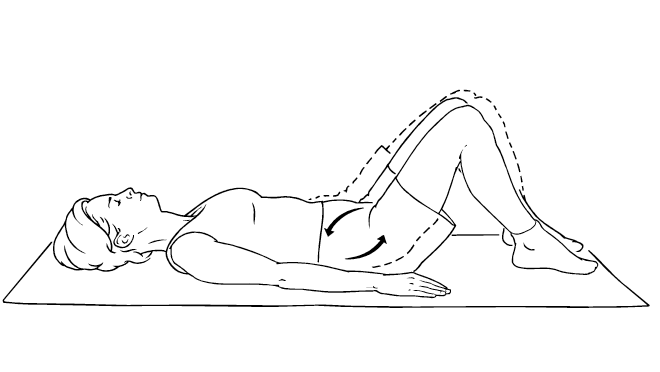
And the reasons are divided into relative, when there is a possibility of health problems in the pregnant woman and the baby, and absolute - the woman has a pathology of the birth canal, in which natural childbirth is impossible.
Planned intervention is carried out in the following cases:
- placenta previa and accreta;
- failure of the scar on the uterus after caesarean section, removal of myomatous nodes, etc.;
- narrow pelvis II degree and above, deformity of the pelvic bones, volumetric formations of the ovaries, uterus, cicatricial cervix and vagina;
- severe symphysitis - a change in the pubic joint with significant pain and inflammation;
- previous plastic surgery on the cervix, vagina, trauma;
- with breech and mixed breech presentation of the fetus, with multiple pregnancies, when other aggravating factors are present;
- malignant neoplasm, uterine fibroids with multiple nodes;
- transverse position of the fetus, developmental delay, weight - 4500 grams or more;
- severe pre-eclampsia and eclampsia, a history of kidney transplantation in a pregnant woman;
- high myopia with changes in the fundus;
- herpes of the vulva with eruptions;
- death or disability of a child during previous births, repeated IVF attempts with additional complications.
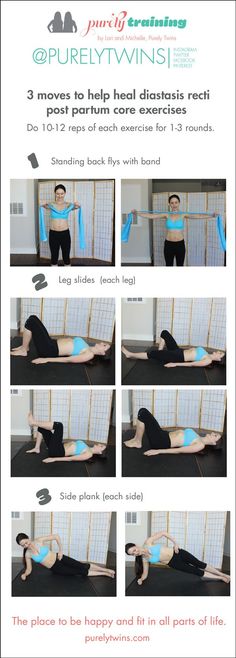
Emergency intervention is performed in case of placenta previa, its ingrowth, bleeding, premature detachment of a normally located placenta, with a threat or completed rupture of the uterus along an old scar, acute fetal hypoxia, general diseases with a deterioration in the condition of the pregnant woman.
Indications for surgery in labor that has already begun, when there are contractions and / or water has broken, are a clinically narrow pelvis in a pregnant woman, weakness and discoordination of labor, foot presentation, prolapse of parts of the fetus or umbilical cord.
Consequences of caesarean section
Caesarean section, like any operation, is associated with negative consequences. Let's consider the most frequent ones.
First of all, an infectious process is possible. The condition of the seams, body temperature should be monitored. Also pay attention to your feelings and the nature of the discharge: if there are pains, there is more discharge, they have acquired a greenish tint and an unpleasant smell, you must urgently see a doctor and exclude inflammation of the inner layer of the uterus (endometritis), appendages (adnexitis), fiber (parametritis). They can lead to sepsis, cycle disorder, infertility.
They can lead to sepsis, cycle disorder, infertility.
You also need to keep in mind the type of anesthesia. As a rule, a planned intervention is performed under spinal anesthesia. After it, back pain, weakness and trembling in the legs may remain. But these are temporary phenomena: they gradually pass.
Seam edges may come apart. The cause of this complication is most often overweight or excessive exercise.
In some cases, adhesions develop that cause abdominal pain, disruption of the gastrointestinal tract.
How can these consequences be reduced?
First of all, a comprehensive examination of the pregnant woman is necessary. Women who are expecting a baby should be responsible for the doctor's prescriptions, take tests on time and take medications if they are prescribed by an obstetrician-gynecologist
The next important point that affects the recovery time after cesarean is the quality of the operation itself, which is affected by the chosen technique, materials, drugs used during and after the intervention, including antibiotics. A woman should carefully study the information about the maternity hospital where she plans to give birth, find a competent doctor whom she will trust and who will conduct the birth.
A woman should carefully study the information about the maternity hospital where she plans to give birth, find a competent doctor whom she will trust and who will conduct the birth.
We need competent care for the postoperative suture during the rehabilitation period. In the maternity hospital, nurses treat the wound. Upon discharge, you will be given recommendations on how best to care for the wound so that it heals faster. If, despite the thoroughness of the treatment, you see that pus is draining, there is bloody discharge from the wound, the skin around it turns red, incomprehensible pains appear - be sure to consult a doctor.
How to get in shape faster after a cesarean
In order for the recovery to proceed smoothly, you need sufficient sleep and rest. Rest is good for both physical and mental health of a woman. Do not hesitate to ask for help from loved ones in caring for the baby, in solving everyday issues.
Try to rest during the baby's daytime sleep: you don't need to run headlong to redo household chores as soon as the baby falls asleep. Remember, the most valuable thing right now is your health, not pots full of food and a shiny apartment. Therefore, calmly go to bed nearby or just lie down.
Remember, the most valuable thing right now is your health, not pots full of food and a shiny apartment. Therefore, calmly go to bed nearby or just lie down.
If you are worried about pain, because of them it is impossible to sleep after a cesarean and do your usual activities, you do not need to endure: consult a doctor so that you can find a safe painkiller.
Breastfeeding
With operative delivery, there may be difficulties with breastfeeding. The reason is the effect on the baby of drugs that were administered to the woman during and after childbirth. Features of the neonatal period also play a role. Natural childbirth is physiological for the child, and the operation can lead to adaptation disorders.
It must be borne in mind that a woman is recommended a diet after surgery. Because of this, problems with the formation of lactation are possible. According to studies, the amount of nutrients in the milk of an operated woman is reduced. Quantity also suffers.
What can be done?
- Early breastfeeding - in the first 2 hours after delivery. The use of spinal anesthesia allows this to be done, since the mother is conscious. If, for medical reasons, it is impossible to attach the newborn to the breast, it is necessary to express the breast periodically;
- If you are a young and inexperienced mother, ask the medical staff to show you how to properly attach the baby to the breast (lying on the side, sitting). This will help to avoid cracks in the nipples;
- To stimulate lactation, procedures such as UHF, massage, and ultrasonic exposure can be carried out. Some herbal remedies are also effective: anise, oregano, dill or pharmacy fees. Sometimes special mixtures or herbal preparations for nursing are prescribed.
Take care of a nursing bra. They perfectly support the chest due to the wide straps, do not squeeze the blood vessels. In addition, there are many options on the market now that are not only comfortable, but also beautiful.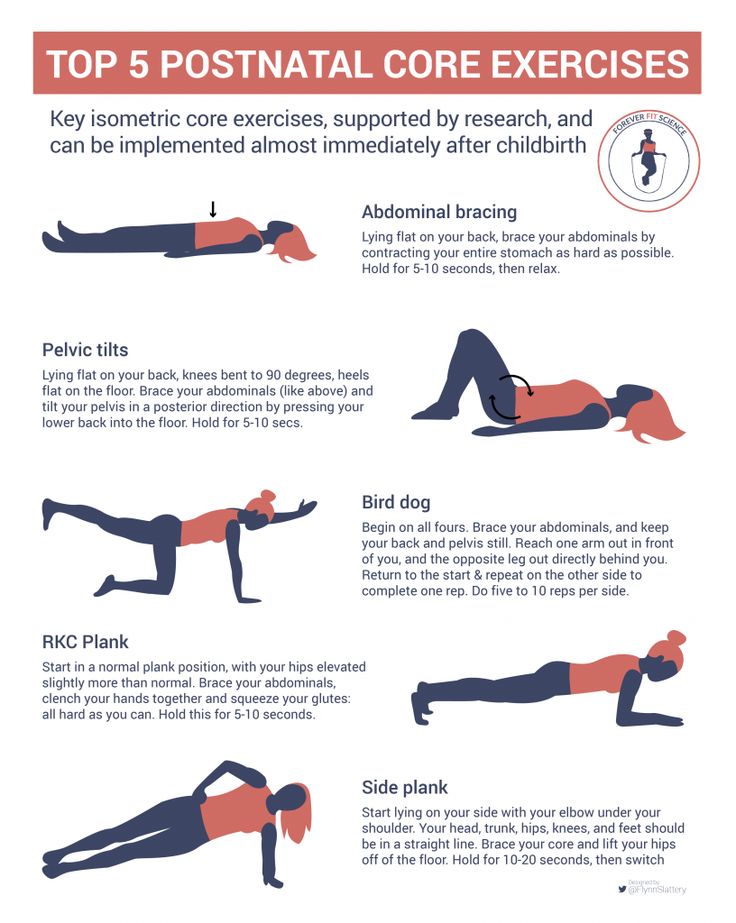 Do not be lazy and study the quality of materials and seams on linen.
Do not be lazy and study the quality of materials and seams on linen.
Necessary restrictions after caesarean section
For the first 1.5-2 months, it is worth limiting weight lifting with a weight of more than 3.5-4 kg and active sports.
Loads begin to turn on gradually after a month and a half. Of course, before that, you need to consult with your doctor: there may be shifts taking into account the characteristics of your body.
From exercises, exclude those that involve stress on the shoulders, arms, upper back, as this can affect milk production. Also avoid bending over, squatting.
Sexual relations are prohibited for the same period (1.5‒2 months). In this matter, you should also rely on the recommendations of the gynecologist who will guide you in the antenatal clinic. If the doctor does not prohibit, there is no discharge, but there is a desire, then there are no restrictions. Consider in advance how you will protect yourself.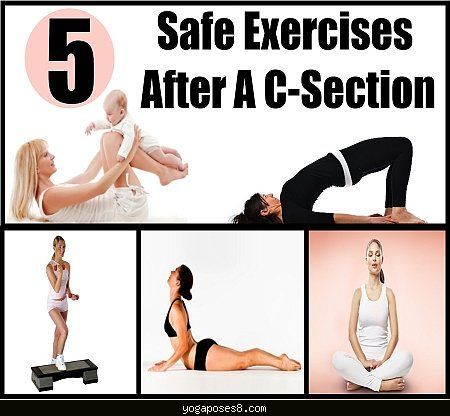
After cesarean, you can not take a bath, visit baths and saunas. A warm shower is the preferred option.
We think there is no need to talk about the dangers of stress for mom.
Recovery process after caesarean section
To recover quickly after a caesarean, you need to follow some recommendations. They relate to physical activity, nutrition, wearing special devices.
Physical activity
Movement is life. But in this case, physical activity should be moderate. With this approach, you will recover quickly and without complications.
Usually, 3-4 hours after a caesarean, a woman in labor can bend and unbend her arms and legs. After a while, she will be able to roll over - doctors recommend doing this regularly so that there are no congestion and adhesions, and thromboembolic complications do not develop.
Lying, do light gymnastics: rotate with your hands, feet, make various movements with your fingers (rotation, flexion and extension).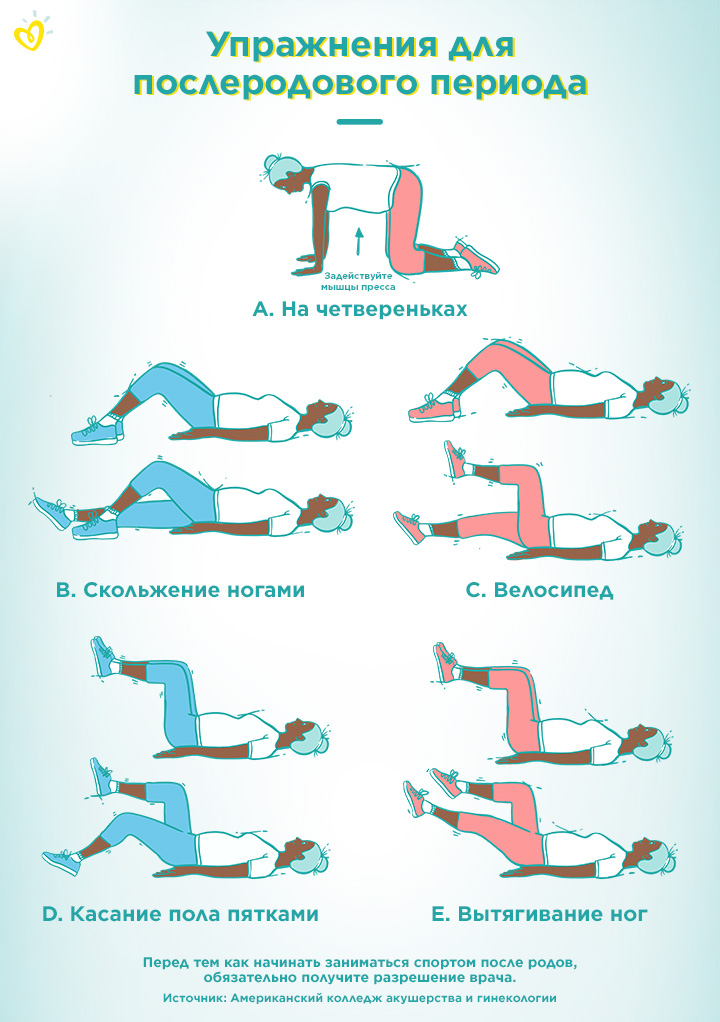 Exercises with dilution and adduction of the legs bent at the knees (in the prone position) can be useful. Focus on your well-being and feelings.
Exercises with dilution and adduction of the legs bent at the knees (in the prone position) can be useful. Focus on your well-being and feelings.
If the recovery after cesarean goes smoothly, the woman is allowed to get out of bed already on the first day: with the help of relatives or maternity hospital staff. You can not make sudden movements: act smoothly and carefully. Over time, you will be able to periodically get up and walk around the ward. Help yourself with your hands so that there is no divergence of the seams: hold on to the headboard or the wall. If you have dizziness, weakness, tell your doctor.
It will be more comfortable to sleep on your back or on your side. You can't lie on your stomach. Firstly, the breast is compressed, which will affect lactation. Secondly, there is pressure on the stomach, the stitches are pulled.
Power supply
If the operation was performed under spinal anesthesia, immediately after it is completed, the woman can drink.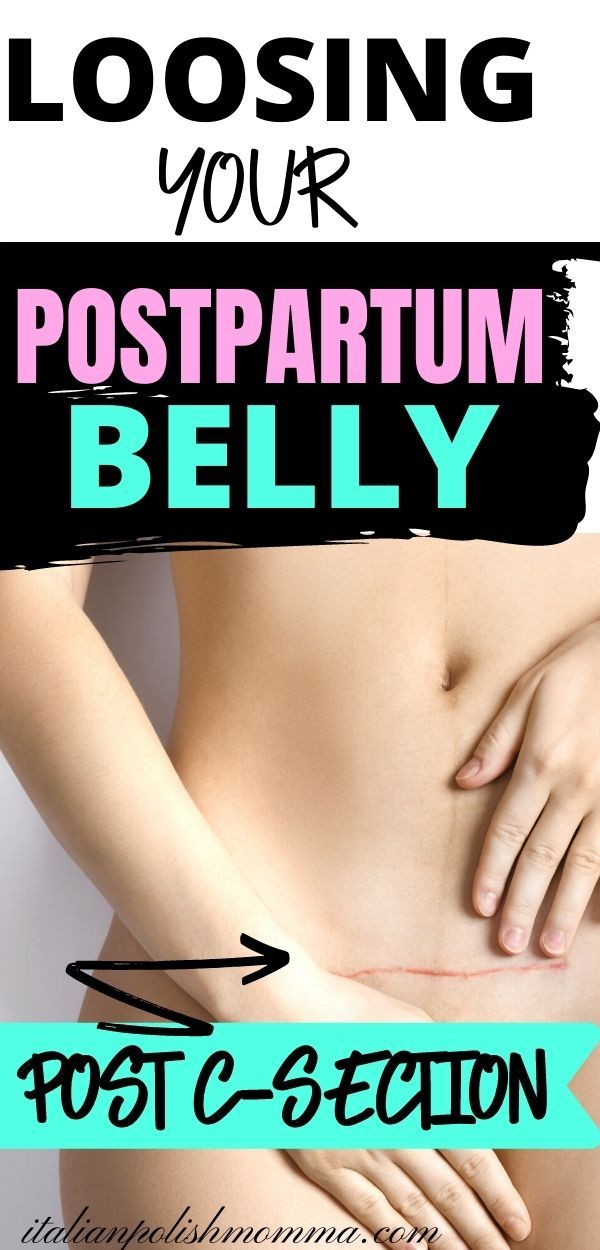 Eating is allowed starting from the first hour. Forbidden: fruits, vegetables, bread. It is also necessary to exclude foods that cause increased gas formation: smoked meats, fatty foods, seasonings. They can lead to abdominal pain and spasm, problems with stitches, and colic in the baby.
Eating is allowed starting from the first hour. Forbidden: fruits, vegetables, bread. It is also necessary to exclude foods that cause increased gas formation: smoked meats, fatty foods, seasonings. They can lead to abdominal pain and spasm, problems with stitches, and colic in the baby.
When general anesthesia is used, fluid intake is allowed after 2 hours. After 6 hours, you can drink the broth, and after a day, you can eat ordinary food.
Bandage wear
The bandage relieves tension from the abdominal muscles, promotes rapid recovery after a cesarean. It is important to choose it individually, according to your size.
You also need to take into account that you need to gradually reduce the time of wearing the bandage in order to prevent muscle atrophy. At first, you wear a bandage all the time. Every day, reduce the wearing time and put it on before walking, bathing the child and other physical activities.
Physical activity
Loads improve mood, reduce depression, allow you to keep weight under control, and normalize bowel function.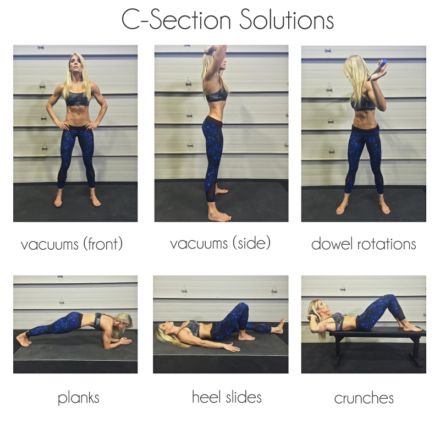
In the beginning, walking will be useful: both for your recovery and for the baby. Try to go outside every day. Dress your child according to the weather. It is advisable to walk away from the tracks.
Fitball exercises will also help to tone the muscles. Combine classes with gymnastics for the baby - then you will get a double benefit.
If you did yoga, fitness before giving birth, you can start exercising after 2 months. In the beginning, classes should be easy. In general, it is not recommended to exhaust yourself during this period.
Do not forget about rest and good nutrition: together with physical activity, they contribute to a quick recovery after a cesarean.
The rehabilitation of a woman takes a long time. After the wounds have healed, you can begin to perform exercises to strengthen the muscles of the abdomen, buttocks, lumbosacral region, thighs, and pelvic floor. It is advisable to exercise under the supervision of a rehabilitation specialist.
Menstrual cycle
The restoration of the cycle can occur at different times: it's all individual. For some, menstruation begins after 3 months, and for someone only after a year. Lactation, age, nutrition, lifestyle, rest, stress, existing diseases play a role.
Although prolactin levels increase during lactation, which suppresses ovulation, the absence of periods does not mean that you cannot become pregnant. If not protected, conception can occur in the very first cycle, when ovulation occurs. Therefore, discuss with your gynecologist which method of contraception is preferable in your case. Experts recommend planning the next pregnancy no earlier than 2 years later. So, for 2 years you must protect yourself.
Pay attention to the nature of the discharge. The first days of the cycle may be accompanied by prolonged bleeding. Over time, everything gets back to normal. But if this lasts for a long time, it is better to see a doctor. You can not leave this symptom unattended: you risk losing a lot of blood.
 Make sure your fingers are pointed toward the ceiling
Make sure your fingers are pointed toward the ceiling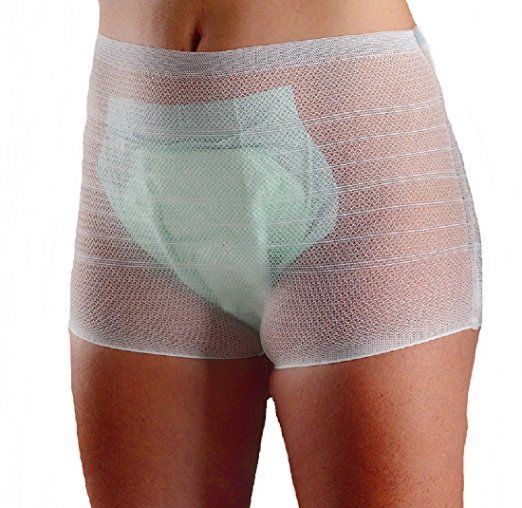 With every exhale, move more deeply into your forward fold. Stay in this position for 5-10 seconds
With every exhale, move more deeply into your forward fold. Stay in this position for 5-10 seconds Externally rotate the lifted leg, turning your left toes and knee out to the side
Externally rotate the lifted leg, turning your left toes and knee out to the side 